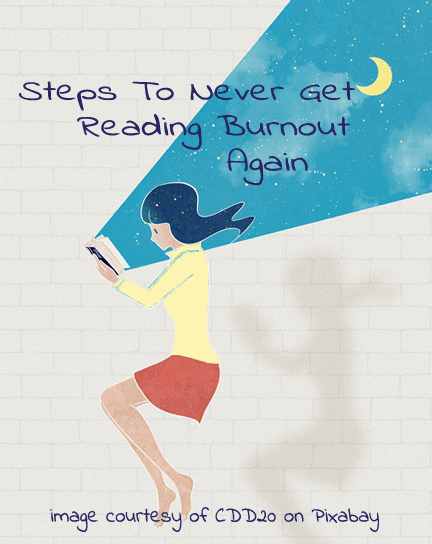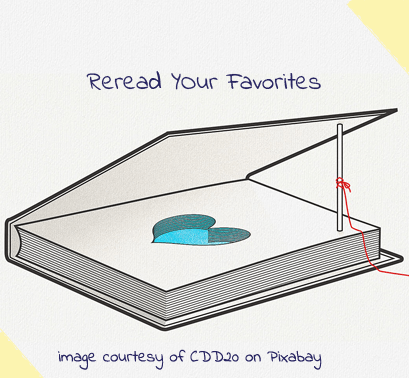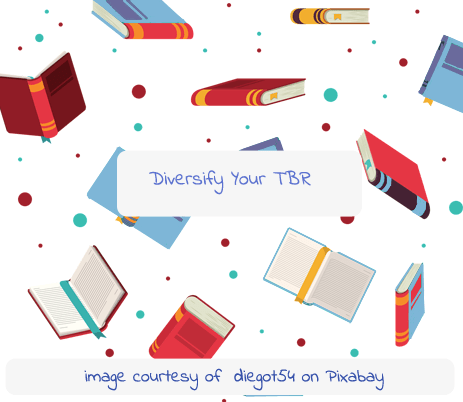If you are reading this post, you probably know what it’s like to have reading burnout. I sure do. I loved reading so much that I dedicated a whole college degree to it. Let me explain. I studied literature at university. My university years were the best. I lived in stories: read them, thought of them, talked about them, and analyzed them. Repeating the cycle was a joyous existence. Reading was easy when a class had several required books to read.
In real life, however, things are more complicated. As a book blogger, it’s hard to keep up with new releases and even harder not to lose steam while trying to catch up. For years, I was prone to reading burnout. I would drag my way through stories, hating every second of it. That was the case until I became more mindful of my reading habits. Doing this was the first step to sustaining my reading enjoyment.
This post is all about how I reshaped my relationship with reading. I am going to talk about things I do to avoid reading burnout altogether. Before you continue, remember that reading habits are personal. What works for me might not work for you—and that’s okay. These are ideas. Some may work for you, and others may not. I urge you to customize your reading schedule, to-be-read piles and reading tracking. Make it your own, because it is your own. Be open to altering your reading routine depending on life changes or new self-discoveries.
Read What You Like
The adage goes, “do what you love, and you will never work a day in your life.” When recovering from reading burnout, this statement should be your mantra. Read what you like. If reading a certain book feels like a chore, put it down.
Doing this saves you from a major cause of reading burnout: a lack of passion. To tap into what you like to read, I recommend brutal honesty. Try to detach from what is currently popular and see how you feel about certain stories. Are you skimming the pages of a book, totally bored? Maybe the story isn’t for you. Secondly, I suggest reflecting frequently on how you are feeling while reading a book. Are you uninterested in the story completely or do you find it interesting but it isn’t what you need at this moment? Is a character irritating while also serving the story’s purpose or do you dislike the character so much that the story’s purpose falls flat?
My biggest foe with reading burnout is here. I struggle with letting go of stories. But, in the spirit of giving you the courage to ditch books that you don’t like, let me take the heat off of you for a second.
Some Popular Books that Dina Put Down After Three Reading Attempts Over the Years:
- Graceling by Kristin Cashore
- Legendborn by Tracy Deon
- Artemis Fowl by Eoin Colfer
- The Long Way To A Small Angry Planet by Becky Chambers
- Thirteen Reasons Why by Jay Asher
- Coldest Touch by Isabel Sterling
- Stargirl by Jerry Spinelli
- The School for Good and Evil by Soman Chainani
- Anne of Green Gables by L.M. Montgemory
See? I am still here. Nothing happened to me. My bookish person card hasn’t been revoked, and yours won’t be either.
Before you destroy your bookshelves, I suggest you do this with each individual read, rather than unhauling all the books that don’t work for you right now. If you are going through a reading burnout, the last thing you would want is to judge whether you want to keep any books around. Focus on right now. What story will keep you engaged? Use this attitude as your guide. Celebrate stories that make you want to turn the page.
Start With Quick Reads
When you are ready, choose a book that fits your needs at the moment. What do you crave as a reader? Fast-paced books tend to be a good point of reentry for me. Lest you feel stifled, let me caution you from thinking that a fast read has to be a short contemporary story. It doesn’t have to be so, and you have more options than this genre.
Depending on how reading burnouts manifest in your life, you might want to try a few genres, pacing tempos, and formats altogether.
- Pacing: mysteries tend to be gripping reads. If adult thrillers aren’t your jam (like me), allow me to share some other ideas. Young Adult mysteries have grabbed my attention without being disturbing. I enjoyed the audiobook for A Good Girl’s Guide to Murder by Holly Jackson. On my TBR is Maureen Johnson’s Truly Devious and Name of the Star trilogy, too. Next, consider paranormal mystery. I’m currently reading Jackaby by William Ritter. It combines mystery with just enough paranormal elements to make it more unpredictable.
- Format: Pacing is not the only way a book can feel like a fast read. The format is another element to keep in mind. I recommend trying audiobooks from your library or a comic book. Also, I want to encourage your to try books that don’t follow the same format as a typical book. Some stories don’t have as many words per page, which leads to flipping more pages to read more of a given story.
- Genre: Changing up the central concerns within your reads can keep books interesting. For instance, a young adult story around vampires may highlight different ideas as opposed to a historical analysis of the origins of vampirism within literature. Even though both works might center on vampires, the way the authors go about it in different ways. Varying the genres can still keep you on your toes.
Whatever you end up reading, frequently check in to see if you are enjoying it. Don’t force yourself to sit through stories that don’t spark curiosity or engagement. Take comfort in knowing that there are plenty of stories out there. Some are just not going to be something you like. That’s okay. Release the idea of required reading. You read what works for you, what enriches your life, and what brings you value.
Reread Your Favorites
Next, revisit your favorite stories. Whether I am on the verge of reading burnout or not, some stories are soothing to return to. Rereads help you gain an appreciation for old favorites. You get to fall in love with reading all over again because you already know this story was impactful to you. Plus, it is a less stressful reading experience because you vaguely already know what’s to come.
What’s on Dina’s re-read list? Rachel Hawkins’s books, especially the Hex Hall series and Rebel Belle. Cassandra Clare’s Shadowhunter series is another hit. I have also enjoyed revisiting the Hush, Hush books by Becca Fitzpatrick.
So how does one determine if a book is a good candidate for a reread? Think back on books that made you stay up all night. Recall stories that you thought of often. What was a book you scoured library bookshelves or bookshops to read its sequel? Is there a story that felt like a life-raft to you? All these stories could remind you of the power of reading. Seek them out.
Diversify Your TBR
Reading the same type of stories (to me) can lead to reading burnout. Diversifying my book choices has made reading far more enjoyable. My suggestion is to include a wider range of voices exploring your favorite themes, storylines, or genres. I won’t say that there’s a science to it.
- Themes:
The more you read, the more you see that there are universal themes present in stories. Fresh approaches to themes can act as a way to diversify your story intake. Good vs. Evil in a story about superheroes looks different than in a magical realism narrative. Changing up your books thematically can keep your reading experiences fresh and interesting.
- Perspective
Changing up perspectives in books can also help you avoid reading burnout. As someone who studied literature, I am a sucker for a reimagining of a classic. To me, new perspectives have always been about including more voices in what are very selective spaces. In university, I certainly noticed how limited perspectives show up in literature. So, to me, I felt unwelcome in most literary discussions. As a reader (and blogger) now, I am trying to read more stories that challenge this literary canon. Shake things up. Any book that retells Jane Eyre will always make my heart beat a little faster. Right now, I have The Mad Woman Upstairs on my shelves, ready to be summoned.
- Tone:
On another note, consider shifting tones within your books to keep your reading experiences interesting. Each tonal shift within a genre can give you a completely different reading experience. For example, if I am in the mood for a story about a witch, I can pinpoint which mood I’m looking for in a witch story. The Caster Chronicles by Kami Garcia and Margaret Stohl somberly deals with witches. It focuses on morality and the duality of good vs. evil. For a lighthearted witch story, I pick up Rachel Hawkins’ Hex Hall. It’s a humorous story more centered around a mystery and human vs. vampire tensions. Both series include witches but do so in different ways.
- Format:
Differing story formats also help. Pick up an audiobook, graphic novel, a story in verse, or short story collection. The change could keep reading as fresh and enjoyable as when you first picked up a book.
Honor Your Energy
As I read more conscientiously, I became aware of its impact on my well-being. I reflected, “What books would help me feel better right now?” Doing so led me to see reading as a helpful, educational, emotional, and imaginative tool. It wasn’t a task on my to-do list. It became a treat, not a chore. There are elements I consider before picking up a book. They are the following: a) interest, b) pacing, c) mood, and d) emotional bandwidth.
Interests:
Your interests ebb and flow. Some stories will lead you to others. A fantasy story about pirates can lead you to a contemporary novel about an immigrant’s identity growing up. Don’t overthink it. You can put a book down if you’re not interested in it. Some of my favorites were once books I didn’t think I liked.
Pacing:
How fast do you want your book to go? Do you want a story with less dialogue and more action? Honor that wish. You can do that; and in doing so, you’d be taking steps to enjoy reading for yourself. Do you want more flowery, descriptive, and slower pacing? Go for it. At the end of the day, it’s your hobby. You make the rules. Approaching it this way has reduced the severity and reoccurrence of a reading burnout.

Honor Your Mental Health
Another tip to keep in mind is to check-in prior to prior to picking up a book. This advice works on two levels. First, know your triggers. What are story elements that could harm your mental wellbeing? Honoring your mental health this way can help you avoid a reading burnout. If you allow yourself room to shield yourself from harmful stories, you can then proceed to the next level: selecting novels based on your emotional state.
The way I think of it, your mood and emotional bandwidth should play a role in your book selection process to avoid reading burnout.
Mood:
Summaries and keywords provide information to help me decide if a story works for my mood. Even still, I am flexible with putting books down if they don’t grab my attention. Allowing myself to do this has reduced the tendency to get reading burnout. My advice is to check in with yourself. Examine your mood. What kind of story would help you at this moment? Do you want to laugh? Does a slow-burn romance sound better? Honor your mood to truly enjoy reading as a hobby.
Emotional Bandwith:
Spoilers and trigger warnings have helped me with bridging the gap between my emotional bandwidth and reading. I have been discovering what drains and what energizes me. Yes, some books will deal with hard-hitting elements. However, there is a difference between being challenged and being harmed. Reach for your internal balance between challenge and harm. Honor this balance to avoid hurting yourself. In doing so, you would be avoiding a reading burnout, on an elementary level, and on a much bigger level, you could be avoiding causing major harm to your wellbeing.

Ditch the Numbers
As a notorious mood reader (with a mood disorder), I have to admit that numbers pushed me toward many a reading burnout. I find them demotivating and frustrating. If you follow me on Goodreads, you’ll see that I have somewhere around 7-10 books marked as “currently reading.” I read books depending on how I am feeling and what I am into at that specific moment. Furthermore, I take breaks. Sometimes they’re long ones, too.
Because of this, numbers don’t work for me. If that’s the case for you, too, I suggest removing them from your approach to reading as a whole. It may seem simple, but it has worked for me in recovering from reading burnout. I think it’s about knowing yourself, and acknowledging what works best for you. What motivates you? Some are driven by having an end-goal number to read annually and/or monthly.
While it’s common, it doesn’t have to be the thing for you. It’s not for me. You can sit with me at this table. Numbers pressure readers to speed through stories, rather than taking the time necessary to process them. I don’t want to read things that I am not taking in. It’s not enjoyable, nor is it allowing stories to have enough impact. Some stories take time. I have felt this while reading Howl’s Moving Castle by Diana Wynne Jones. It’s a children’s book and the slower I went, the more I got to savor the story and its characters.
Treating all reading experiences as the same is unfair to books, their messaging, and readers. Having a more solid, intimate experience with what you read is key to regularly read. To do that, you focus on your connection with each story, each element that sings to you, and each page you savor.

Take a Break
Too much of a good thing can ultimately ruin your enjoyment of the said thing. No matter how good of a thing it may be, you may just be in need of a break. There’s comfort in knowing that you don’t have to force anything. Your reader card is not about to be revoked if you take a break. Your reading habits are valid no matter what. So, I urge you to take a break. Take lots of breaks, if needed.
Reading burnout is usually an indication that you need to disengage from your current approach to reading. Sometimes, this can be a rerouting of how and what you read. But, sometimes, a break can give you time to come back and start fresh, without the overwhelm and the frustration of trying to keep up.
Above all else, reading is a tool to navigate the world. No pressure, I know. But, really, it is supposed to help you, not stress you out. Use the reading burnout as a signal, not an indication of some sort of failure. Stories aren’t going anywhere. You can always come back. I did. It’s not something you defeat. I know, I know. The title of the post is all definitive. But, it’s also a matter of nuance. Be flexible, be gentle, and be kind to yourself. You matter. Your reading is valid.
I hope this post gives you room to customize your approach to reading stories. May good words, good pages, and good stories find their way to you.




You must be logged in to post a comment.